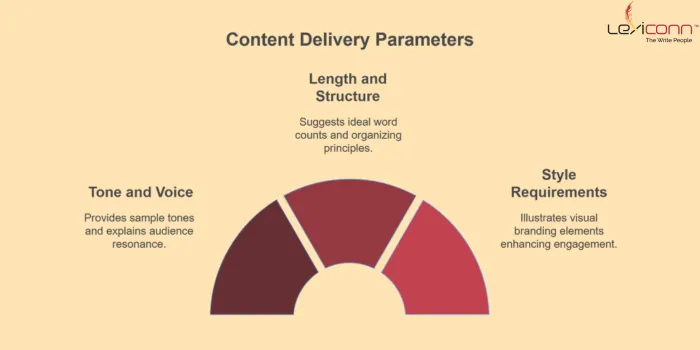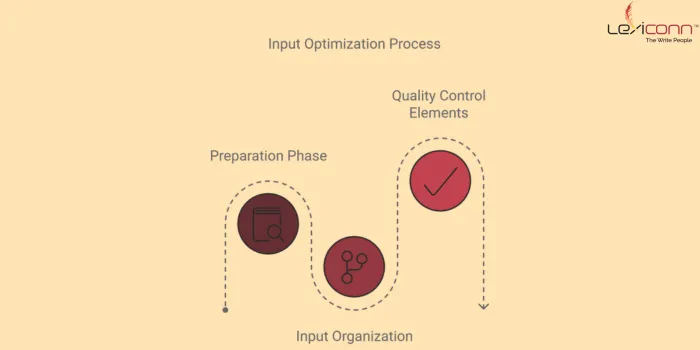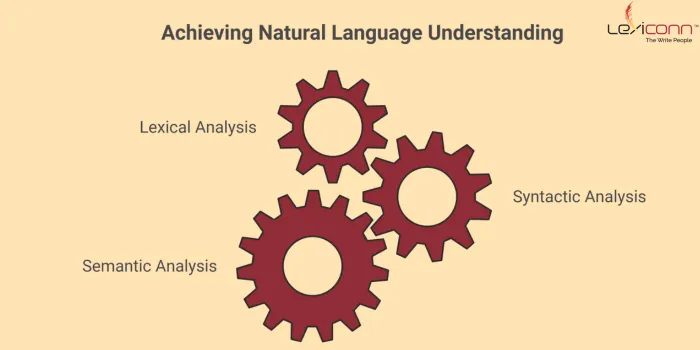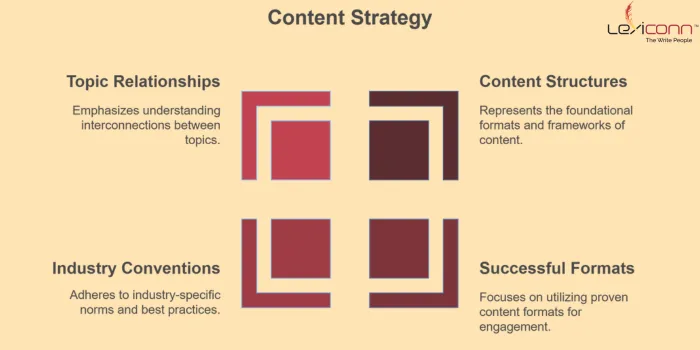

AI content writing refers to using artificial intelligence tools and language models to generate or assist in creating written content. It works through advanced natural language processing (NLP) and machine learning algorithms that have been trained on vast amounts of text data.
Here's how it typically works:
The success of AI-generated content heavily depends on how well you structure and provide your inputs. Think of it as teaching a highly capable student – the more precise and detailed your instructions, the better the output. This comprehensive guide explores the crucial input phase of AI content writing and how to optimize it for superior results.
Effective AI-driven content creation hinges on three foundational elements: prompts, parameters, and content refinement. Mastering these ensures precise, relevant, and high-quality outputs.
Prompts serve as the primary instructions for AI writing tools. The key to successful prompting lies in specificity and clarity. Rather than writing "Create content about digital marketing," a better prompt would be "Write a comprehensive guide about email marketing strategies for small e-commerce businesses, focusing on increasing open rates and conversion."
Keywords play a dual role in AI content creation – they guide the AI's focus and support SEO objectives.
A well-structured outline serves as the backbone of your content. It helps the AI maintain logical flow and comprehensive coverage.
Parameters define how the content should be delivered, ensuring alignment with tone, structure, and style preferences.

The tone determines how your content connects with readers. AI tools can adjust their writing style based on specified parameters.
Clear length parameters ensure content meets specific requirements and maintains reader engagement.
Style settings ensure consistency with brand guidelines and industry standards.
Existing content can provide valuable inspiration or serve as a foundation for refinement, saving time and enhancing relevance.
Many AI tools allow you to upload existing content for refinement or inspiration.
By mastering these pillars, you'll unlock the full potential of AI tools, producing tailored, impactful, and highly engaging content.
Effective input optimization ensures clear communication and maximizes the efficiency of content creation.

Here’s a structured approach to streamline your input process:
By adhering to these best practices, teams can create more effective and impactful content with fewer revisions.
LexiConn's team of content strategists can assist you in optimizing your input process. We help businesses craft precise prompts and parameters to maximize the quality of AI-generated content.
Missteps in input optimization can derail the process. Here’s how to identify and prevent them:
The input phase of AI content writing is crucial for generating high-quality, relevant content. Avoiding these pitfalls can be challenging without expert guidance. LexiConn | Content marketing agency in Mumbai provides personalized support to help you navigate these challenges, ensuring your AI content aligns with your goals and resonates with your audience.
Remember that AI content writing is an iterative process – monitor results, gather feedback, and adjust your input strategies accordingly. The more you refine your input methodology, the better your AI-generated content will become.

When AI receives your carefully crafted inputs, it enters a complex processing phase where Natural Language Processing (NLP) and machine learning algorithms work together to generate content. Understanding this phase helps content creators better appreciate the capabilities and limitations of AI writing tools.
Natural Language Understanding is the foundation of AI content writing tools. These tools analyze inputs through three distinct layers, breaking down content into understandable components.

This layered approach enables AI to comprehend and process human language effectively. Each layer builds upon the previous one, creating a comprehensive understanding of the input text. Together, these analysis layers form the basis for generating relevant and coherent content.
AI content generation relies heavily on its training data utilization. The system processes inputs by drawing from extensive datasets of content and patterns.
Pattern recognition forms the first step, where AI identifies content structures and analyzes successful formats within specific industries. Content framework matching follows, where the AI aligns with proven writing structures and narrative patterns while implementing effective rhetorical devices.

The final step involves style and tone adaptation. Here, the AI matches requested writing styles, adjusts language complexity, and maintains consistent voice while following brand guidelines. This three-step process ensures the generated content remains relevant and aligned with desired outcomes.
AI applies language patterns through two key processes: content organization and narrative development.
Now that you've learned about inputting prompts and how AI processes them, let's focus on something crucial - ensuring your AI-generated content actually meets your standards. Think of this as your quality control playbook for getting the best possible results.
Remember, AI is a powerful tool, but it's not a "set it and forget it" solution. The best results come from treating it as a collaborative process between human expertise and machine efficiency.
The key is to start with these practices and then adapt them to your specific needs. As you work more with AI content generation, you'll develop an intuition for what works best for your particular use case.
As AI content writing technology matures, its applications continue to expand across various content formats and business needs. Understanding these applications and their strategic advantages helps organizations leverage AI writing tools effectively for maximum impact.
AI-driven tools are transforming the way businesses create content by increasing efficiency and consistency. From blog posts to customer education materials, the versatility of AI makes it a vital asset for the modern age.
AI’s capabilities transform content creation into a strategic asset, empowering businesses to scale efficiently. As we explore the strategic advantages of AI tools, their speed, efficiency, and consistency will come into sharper focus.
From ensuring consistent messaging to operating around the clock, AI is a game-changer in content creation. Here’s how it delivers speed, efficiency, and cost-effectiveness without compromising quality.
Next, we’ll explore how businesses can implement these tools effectively for maximum results.
Adopting AI requires thoughtful planning and integration to maximize its benefits. Businesses must align content workflows with their strategic objectives while ensuring smooth implementation.
From quality assurance processes to team training, successful integration ensures AI becomes a seamless part of the content creation journey. Let’s look at how to implement AI effectively.
| Content Planning | Quality Assurance | Integration Process |
|---|---|---|
|
|
|
|
|
|
|
|
|
|
|
|
|
|
|
Implementing AI content writing tools can be seamless with LexiConn's assistance. Our services include content planning, quality assurance, and integration processes tailored to your business objectives. In the next section, we’ll dive into best practices for maximizing impact and achieving sustainable results with AI-driven content.
AI content writing has revolutionized content creation across multiple applications, offering significant advantages in speed, consistency, availability, and cost-effectiveness. Success lies in understanding these applications and advantages while implementing appropriate strategies for quality control and optimization.
As the technology continues to evolve, organizations that effectively leverage AI content writing tools while maintaining quality standards will gain a significant competitive advantage in their content marketing efforts. The key is to balance automation with human oversight, ensuring both efficiency and quality in content production.
At LexiConn, we strike this balance by combining cutting-edge AI tools with professional editorial oversight. We ensure that your content is not only produced efficiently but also meets the highest quality standards.
Schedule a Free Consultation with LexiConn! LexiConn offers a free 30-minute content consultation session to help you with your content strategy.
Visit us www.lexiconn.in or drop us a line at [email protected].



I have read and accept the Privacy Policy
Read More